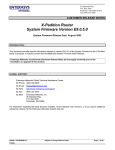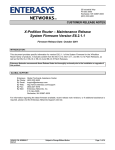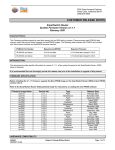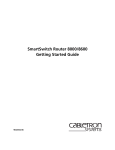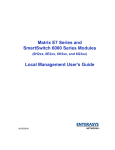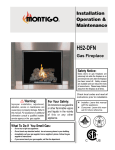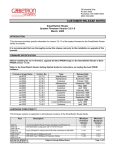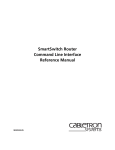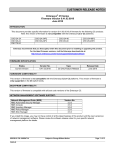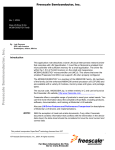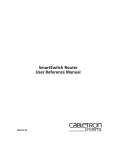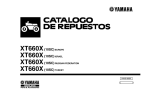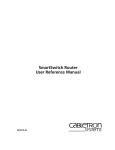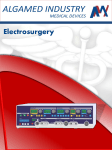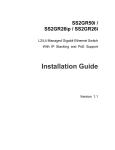Download X-Pedition Router
Transcript
50 Minuteman Rd. Andover, MA 01810 USA Tel: (978) 684-1000 CUSTOMER RELEASE NOTES X-Pedition Router System Firmware Version E9.1.9.0 System Firmware Release Date: March 2004 INTRODUCTION: This document provides specific information relevant to version E9.1.9.0 of the System Firmware for the X-Pedition family of products. It includes content from the E9.0.7.8 System Firmware Maintenance Release. Enterasys Networks recommends that these Release Notes be thoroughly reviewed prior to the installation or upgrade of this product. GLOBAL SUPPORT: By Phone: (603) 332-9400 1-800-872-8440 (toll-free in U.S. and Canada) For the Enterasys Networks Support toll-free number in your country: http://www.enterasys.com/support/gtac-all.html By Email: [email protected] By Web: http://www.enterasys.com/support By Fax: (603) 337-3075 By Mail: Enterasys Networks, Inc. 35 Industrial Way P.O. Box 5005 Rochester, NH 03866 For information regarding the latest software available, recent release note revisions, or if you require additional assistance, please visit the Enterasys Networks Support web site. 02/27/04 P/N: 9038090-56 F0615-K Subject to Change Without Notice Page: 1 of 32 SYSTEM FIRMWARE SPECIFICATION SYSTEM FIRMWARE SPECIFICATION: Before installing the E9.1.9.0 System Firmware, the Boot Firmware should be upgraded to at least version E3.3.0.0. Refer to the E3.3.0.0 Boot Firmware Release Notes, or any X-Pedition Getting Started Guide, for instructions on upgrading the Boot Firmware. System Firmware File Name xp9190 xp9180 xp9170 xp9078 xp9080 xp9077 xp9076 xp9075 xp9074 xp9130 xp9073 xp9120 xp9072 xp9100 xp9071 xp9070 xp9060a xp9050 xp9040 xp9030 xp9020 xp9010 xp9000 xp8300 xp8210 xp8200 ssr8100 ssr8010 ssr8000 ssr3200 ssr3100 ssr3010 ssr3000 ssr2220 ssr2200 ssr2100 ssr2000 ssr1200 ssr1100 ssr1010 ssr1000 02/27/04 P/N: 9038090-56 F0615-K Version No. E9.1.9.0 E9.1.8.0 E9.1.7.0 E9.0.7.8 E9.0.8.0 E9.0.7.7 E9.0.7.6 E9.0.7.5 E9.0.7.4 E9.1.3.0 E9.0.7.3 E9.1.2.0 E9.0.7.2 E9.1.0.0 E9.0.7.1 E9.0.7.0 E9.0.6.0A E9.0.5.0 E9.0.4.0 E9.0.3.0 E9.0.2.0 E9.0.1.0 E9.0.0.0 E8.3.0.0 E8.2.1.0 E8.2.0.0 E8.1.0.0 E8.0.1.0 E8.0.0.0 3.2.0.0 3.1.0.0 3.0.1.0 3.0.0.0 2.2.2.0 2.2.0.0 2.1.0.0 2.0.0.0 1.2.0.0 1.1.0.0 1.0.1.0 1.0.0.0 Release Date March 2004 November 2003 September 2003 September 2003 July 2003 July 2003 June 2003 May 2003 March 2003 March 2003 February 2003 January 2003 January 2003 December 2002 December 2002 November 2002 October 2002 August 2002 July 2002 June 2002 April 2002 March 2002 December 2001 October 2001 September 2001 June 2001 February 2001 October 2000 September 2000 May 2000 April 2000 March 2000 October 1999 September 1999 April 1999 December 1998 November 1998 September 1998 August 1998 June 1998 April 1998 Subject to Change Without Notice Page: 2 of 32 FIRMWARE LIFE CYCLE AND RELEASE NAME CONVENTION FIRMWARE LIFE CYCLE AND RELEASE NAME CONVENTION: Normally, the X-Pedition product family supports two active release lines. The older line is always in maintenance only mode and receives only maintenance improvements—the newer line receives maintenance improvements and introduces new features. E9.1.9.0 is the final development release of the E9.1 line. E9.1 becomes the maintenance-only line for which only bug fixes are provided. E9.0 has reached end of maintenance meaning it will receive no further code changes. E10.0 is now the development line which receives bug fixes and introduces new features. The figure below illustrates the relationships between these lines. EOD or “end of development” signifies the point at which no new features will be added to the release line. EOM or “end of maintenance” signifies the point where bug fixes are no longer applied to the line. The naming convention is as follows. E<R1>.<R2>.<D>.<M> Where: R1 – Release line digit 1 R2 – Release line digit 2 D – A release during the development period M – A release during the maintenance-only period A release line is defined by the first two digits in the name, e.g. E9.0 and E9.1. The third digit increments with each release during the development phase of a line. For example, E9.0.7.0 is the seventh development release for the E9.0 line. The fourth digit is incremented with each release during the maintenance-only period of a release line. Thus E9.0.7.4 is the fourth maintenance-only release for the E9.0 line. Should a bug fix be required between regularly scheduled releases, a patch release is provided. Patch releases are designated with a trailing letter. For example, E9.0.6.0B is the second patch to the sixth development release of the E9.0 line. E9.0.7.2A is the first patch to the second maintenance-only release of the E9.0 line. 02/27/04 P/N: 9038090-56 F0615-K Subject to Change Without Notice Page: 3 of 32 HARDWARE / FIRMWARE COMPATIBILITY HARDWARE / BOOT FIRMWARE/ SYSTEM FIRMWARE COMPATIBILITY: The Minimum Boot Firmware Version is a function of: • The hardware installed in the system (as listed below). • The version of VFS used. For more information on VFS versions see the “PCMCIA Card VFS Version” subsection in the “INSTALLATION AND CONFIGURATION NOTES” section of the X-Pedition Boot Firmware Release Notes. • The need for new features or corrections that are provided in a specific version. The issue of determining minimum Boot Firmware version can be avoided by installing version E3.2.0.0 (or later) of the Boot Firmware. NOTE: In some cases, the Minimum System Firmware Version depends upon the revision of a particular model number. The revision number appears on the serial number sticker attached to the front of all Enterasys Networks hardware assemblies. These numbers are interpreted as follows: AAAA XXXX XXXX XXRR Two Letter Assembly Revision Number Four Digit “940” Assembly Number Example: 3570 0000 0000 000A This number is broken down as follows: • Assembly number 9403570 (In this case, the SSR-POS21-04) • The assembly has a revision number of “0A” For the two SSR-PCMCIA part numbers listed below, sub-part numbers (e.g., 35-028-02) are also listed. Find the sub-part number on the SSR-PCMCIA card. Match it with a sub-part number to aid in determining the minimum System Firmware and Boot Firmware versions. For detailed information on managing the Boot Firmware, please refer to version E3.2.0.0 (or later) of the X-Pedition Boot Firmware Release Notes. 02/27/04 P/N: 9038090-56 F0615-K Subject to Change Without Notice Page: 4 of 32 HARDWARE / FIRMWARE COMPATIBILITY This version of System Firmware supports the X-Pedition Router hardware listed in the following table: Part Description Minimum System Firmware Version Minimum Boot Firmware Version 1.1.0.8 5SSRM-02 6SSRLC-FX-AA Router module for the Matrix E5 8-port 100BASE-FX (MT-RJ) module for 5SSRM-02 and 6SSRM-02 E8.0.1.0 3.0.50.11 6SSRLC-LX-AA 6SSRLC-LX70-AA 6SSRLC-SER-AA 6SSRLC-SERC-AA 6SSRLC-SERCE-AA 6SSRLC-SX-AA 6SSRLC-TX-AA 2-port 1000BASE-LX module for 5SSRM-02 and 6SSRM-02 1-port 1000BASE-LX 70 KM module for 5SSRM-02 and 6SSRM-02 2-port Serial module (No compression or encryption) for 5SSRM-02 and 6SSRM-02 4-port Serial module with compression (No encryption) for 5SSRM-02 and 6SSRM-02 4-port Serial module with compression & encryption for 5SSRM-02 and 6SSRM-02 2-port 1000BASE-SX module for 5SSRM-02 and 6SSRM-02 8-port 1000BASE-TX module for 5SSRM-02 and 6SSRM-02 3.0.50.11 3.0.50.11 3.0.50.11 3.0.50.11 3.0.50.11 3.0.50.11 3.0.50.11 6SSRM-02 ER16-04 ER16-08 ER16-AC ER16-ATM29-02 ER16-CK Router module for the Matrix E6 (SS6000) and Matrix E7 4-port 1000BASE GBIC module [T-Series] for ER16 8-port 1000BASE GBIC module [T-Series] for ER16 AC Power Supply for ER16 2-port ATM OC-3c base module [T-Series] for ER16 Clock module for ER16 3.0.50.11 E8.0.0.0 E8.0.0.0 E8.0.0.0 E8.3.0.0 E8.0.0.0 1.1.0.8 ER16-CM3-128 ER16-CM4-256 ER16-CS ER16-DC ER16-FDDI-02 ER16-FN ER16-GTX32-04 Control Module 3 (291 MHz CPU) with 128MB for ER16 Control Module 4 (380 MHz CPU) with 256MB for ER16 X-Pedition ER16 Chassis with 16 slots. Includes ER16-CK, ER16-FN, and ER16-SF DC Power Supply for ER16 2-port FDDI base module [T-Series] for ER16 Fan Tray module for ER16 4-port 1000BASE-TX module for ER16 E8.0.0.0 E8.2.0.0 E8.0.0.0 E8.0.0.0 E8.3.0.1 E8.0.0.0 E9.0.0.0 E3.0.0.0 E3.1.0.0 ER16-GTX32-08 ER16-HFX31-24 ER16-HFX39-24 ER16-HSSI-02-CK ER16-OS16-01 8-port 1000BASE-TX module for ER16 24-port 100BASE-FX module [T-Series] for ER16 (MMF) 24-port 100BASE-FX module [T-Series] for ER16 (SMF) 2-port HSSI module for ER16 with external clocking 1-port 10-Gigabit Ethernet module for ER16 (1 slot configuration) E9.0.0.0 E8.3.0.0 E8.3.0.0 E8.3.0.0 E9.1.7.0 E3.2.0.0 E3.2.0.0 ER16-OS26-01 1-port 10-Gigabit Ethernet module for ER16 (2 slot configuration) E9.1.0.0 ER16-POS-21-04 4-port OC-3/STM-1 Packet over SONET/SDH MMF module [T-Series] ER16 E9.0.3.0 ER16-POS-29-04 4-port OC-3/STM-1 Packet over SONET/SDH SMF module [T-Series] for ER16 E9.0.3.0 ER16-POS-31-02 2-port OC-12/STM-4 Packet over SONET/SDH MMF module [T-Series] for ER16 E9.0.3.0 ER16-POS-39-02 2-port OC-12/STM-4 Packet over SONET/SDH SMF module [T-Series] for ER16 E9.0.3.0 ER16-SERC-04-AA ER16-SERCE-04-A ER16-SF 4-port Serial module with compression for X-Pedition ER16 4-port Serial module with compression and encryption for X-Pedition ER16 Switching Fabric module for ER16 E8.3.0.0 E8.3.0.0 E8.0.0.0 ER16-SX-08 ER16-TX-24 ER16-TX-32 SSR-16 SSR-2-B128 SSR-2-FX 8-port 1000BASE-SX module [T-Series] for ER16 24-port 10/100BASE-TX module [T-Series] for ER16 32-port 10/100BASE-TX module [T-Series] for ER16 X-Pedition 8600 Chassis with 16 slots. Comes with SSR-FAN-16 and SSR-SF-16. X-Pedition 2000 Chassis with 16-ports 10/100 TX ,128 MB memory, and 2 open slots 8-port 100BASEFX (MT-RJ) module for X-Pedition 2000 E8.0.0.0 E8.0.0.0 E8.0.0.0 1.2.0.0 3.1.0.0 2.1.0.1 SSR-2-FX-AA SSR-2-GSX SSR-2-HSSI-AA SSR-2-LX SSR-2-LX-AA 8-port 100BASEFX (MT-RJ) module for X-Pedition 2000 X-Pedition 2100 Chassis with 8-ports 1000BASE-SX and 64MB Memory 2-port HSSI module for X-Pedition 2000 2-port 1000BASE-LX module for X-Pedition 2000 2-port 1000BASE-LX module for X-Pedition 2000 3.0.0.0 2.2.0.1 E8.0.0.0 1.2.0.0 3.0.0.0 02/27/04 P/N: 9038090-56 F0615-K Subject to Change Without Notice 1.1.0.9 1.1.0.5 Page: 5 of 32 HARDWARE / FIRMWARE COMPATIBILITY Part Description Minimum System Firmware Version SSR-2-LX70 SSR-2-LX70-AA 1-port 70 km 1000BASE-LX module for X-Pedition 2000 1-port 70 km 1000BASE-LX module for X-Pedition 2000 2.0.0.0 3.0.0.0 SSR-2-SER SSR-2-SER-AA SSR-2-SERC SSR-2-SERC-AA SSR-2-SERCE SSR-2-SERCE-AA SSR-2-SX 2-port Serial module (No compression or encryption) for X-Pedition 2000 2-port Serial module (No compression or encryption) for X-Pedition 2000 4-port Serial module with compression (No encryption) for X-Pedition 2000 4-port Serial module with compression (No encryption) for X-Pedition 2000 4-port Serial module with compression and encryption for X-Pedition 2000 4-port Serial module with compression and encryption for X-Pedition 2000 2-port 1000BASE-SX module for X-Pedition 2000 2.1.0.0 3.0.0.0 2.1.0.0 3.0.0.0 2.1.0.0 3.0.0.0 1.2.0.0 SSR-2-SX-AA SSR-2-TX SSR-2-TX-AA SSR-8 SSR-ARE SSR-ATM29-02 2-port 1000BASE-SX module for X-Pedition 2000 8-port 10/100 TX module for X-Pedition 2000 8-port 10/100 TX module for X-Pedition 2000 X-Pedition 8000 Chassis with 8 slots. Comes with SSR-FAN-8. Advanced Routing Engine (currently supports AppleTalk) for X-Pedition 8000/8600 2-port ATM OC-3c base module [T-Series] for X-Pedition 8000/8600 3.0.0.0 1.2.0.0 3.0.0.0 1.0.0.0 E8.1.0.0 3.1.0.0 SSR-CM2-128 SSR-CM2-64 SSR-CM2B-64 SSR-CM3-128 SSR-CM4-256 SSR-FAN-16 SSR-FAN-8 Control Module 2 (198 MHz CPU) with 128 MB memory for X-Pedition 8000/8600 Control Module 2 (198 MHz CPU) with 64 MB memory for X-Pedition 8000/8600 Control Module 2 (198 MHz CPU) with 64 MB memory for X-Pedition 8000/8600 Control Module 3 (291 MHz CPU) with 128MB memory for X-Pedition 8000/8600 Control Module 4 (375/380 MHz CPU) with 256MB memory for X-Pedition 8000/8600 Fan Tray module for X-Pedition 8600 Fan Tray module for X-Pedition 8000 1.1.0.0 1.1.0.0 E9.0.0.0 E8.0.0.0 E8.2.0.0 1.0.0.0 1.0.0.0 SSR-FDDI-02 SSR-GLH39-02 SSR-GLX19-02 SSR-GLX29-02 SSR-GLX29-02-AA SSR-GLX39-02 2-port FDDI base module [T-Series] for X-Pedition 8000/8600 2-port 1000 LLX / LH module (SCLX for SMF) [T-Series] for X-Pedition 8000/8600 2-port 1000 LX module (SCLX for MMF or SMF) with 4 MB for X-Pedition 8000/8600 2-port 1000 LX module (SCLX for MMF or SMF) with 16 MB for X-Pedition 8000/8600 2-port 1000 LX module (SCLX for MMF or SMF) with 16 MB for X-Pedition 8000/8600 2-port 1000 LX module (SCLX for MMF or SMF) [T-Series] for X-Pedition 8000/8600 3.2.0.0 3.1.0.0 1.0.0.0 1.0.0.0 3.0.0.0 3.1.0.0 SSR-GLX39-04 SSR-GLX70-01 SSR-GLX70-01-AA SSR-GSX11-02 SSR-GSX21-02 SSR-GSX21-02-AA SSR-GSX31-02 4-port 1000 LX module (SCLX for MMF or SMF) [T-Series] for X-Pedition 8000/8600 1-port 70 Km 1000BASE-LX module with 16 MB for X-Pedition 8000/8600 1-port 70 Km 1000BASE-LX module with 16 MB for X-Pedition 8000/8600 2-port 1000 SX module (SCSX for MMF Only) with 4 MB for X-Pedition 8000/8600 2-port 1000 SX module (SCSX for MMF Only) with 16 MB for X-Pedition 8000/8600 2-port 1000 SX module (SCSX for MMF Only) with 16 MB for X-Pedition 8000/8600 2-port 1000 SX module (SCSX for MMF Only) [T-Series] for X-Pedition 8000/8600 E8.3.0.0 2.0.0.0 3.0.0.0 1.0.0.0 1.0.0.0 3.0.0.0 3.1.0.0 SSR-GSX31-04 SSR-GTX32-02 SSR-GTX32-04 SSR-HFX11-08 SSR-HFX21-08 SSR-HFX21-08-AA 4-port 1000 SX module (SCSX for MMF Only) [T-Series] for X-Pedition 8000/8600 2-port 1000 TX module (Cat 5 RJ-45) [T-Series] for X-Pedition 8000/8600 4-port 1000 TX module (Cat 5 RJ-45) [T-Series] for X-Pedition 8000/8600 8-port 100 FX module (MMF SC) with 4 MB for X-Pedition 8000/8600 8-port 100BASE-FX module (MMF SC) with 16 MB for X-Pedition 8000/8600 8-port 100BASE-FX module (MMF SC) with 16 MB for X-Pedition 8000/8600 E8.3.0.0 3.1.0.0 E9.0.0.0 1.0.0.0 1.0.0.0 3.0.0.0 SSR-HFX29-08 SSR-HFX29-08-AA SSR-HSSI-02 SSR-HSSI-02-AA SSR-HSSI-02-CK SSR-HTX12-08 SSR-HTX12-08-AA 8-port 100BASE-FX SMF module with 16 MB for X-Pedition 8000/8600 8-port 100BASE-FX SMF module with 16 MB for X-Pedition 8000/8600 2-port HSSI module for X-Pedition 8000/8600 2-port HSSI module for X-Pedition 8000/8600 2-port HSSI module for X-Pedition 8000/8600 with external clocking 8-port 10/100 TX module (Cat 5 RJ-45) with 4 MB for X-Pedition 8000/8600 8-port 10/100 TX module (Cat 5 RJ-45) with 4 MB for X-Pedition 8000/8600 2.0.0.0 2.0.0.0 2.1.0.0 3.0.0.0 E8.3.0.0 1.0.0.0 3.0.0.0 SSR-HTX22-08 SSR-HTX22-08-AA 8-port 10/100 TX module (Cat 5 RJ-45) with 16 MB for X-Pedition 8000/8600 8-port 10/100 TX module (Cat 5 RJ-45) with 16 MB for X-Pedition 8000/8600 1.0.1.0 3.0.0.0 02/27/04 P/N: 9038090-56 F0615-K Subject to Change Without Notice Minimum Boot Firmware Version 1.1.0.2 1.1.0.2 E3.2.0.0 E3.0.0.0 E3.1.0.0 Page: 6 of 32 HARDWARE / FIRMWARE COMPATIBILITY Part SSR-HTX32-16 SSR-MEM-128 SSR-MEM-256 Description 16-port 10/100 TX module (Cat 5 RJ-45) with 16 MB [T-Series] for X-Pedition 8000/8600 128MB Memory Upgrade Kit for SSR-CM2-64, SSR-CM2-128, SSR-CM3-128, and ER16-CM3-128 256MB ECC Memory Upgrade Kit for SSR-CM4-256 and ER16-CM4-256 Minimum System Firmware Version Minimum Boot Firmware Version 3.1.0.0 1.1.0.0 1.1.0.2 E9.0.7.4 or E9.1.3.0 1.0.0.0 E3.3.0.0 E3.0.0.0 SSR-PCMCIA 35-028-01 35-053-01 35-053-02 35-053-03 37-002-01 SSR-PCMCIA 35-028-02 35-053-04 37-010-01 8MB PCMCIA card for SSR-CM2-64, SSR-CM2-128, SSR-CM3-128, SSR-CM4-256, ER16-CM3-128, and ER16-CM4-256 8MB PCMCIA card for SSR-CM2-64, SSR-CM2-128, SSR-CM3-128, SSR-CM4-256, ER16-CM3-128, and ER16-CM4-256 3.0.1.6, 3.0.1.7, 3.1.0.8 and up, excluding 3.2.0.0 SSR-POS21-04 3.1.0.0 SSR-POS39-02 Assy 3567 Rev0A+ SSR-PS-16 SSR-PS-16-DC 4-port OC-3/STM-1 Packet over SONET/SDH MMF module [T-Series] for X-Pedition 8000/8600 4-port OC-3/STM-1 Packet over SONET/SDH MMF module [T-Series] for X-Pedition 8000/8600 4-port OC-3/STM-1 Packet over SONET/SDH SMF module [T-Series] for X-Pedition 8000/8600 4-port OC-3/STM-1 Packet over SONET/SDH SMF module [T-Series] for X-Pedition 8000/8600 2-port OC-12/STM-4 Packet over SONET/SDH MMF module [T-Series] for X-Pedition 8000/8600 2-port OC-12/STM-4 Packet over SONET/SDH MMF module [T-Series] for X-Pedition 8000/8600 2-port OC-12/STM-4 Packet over SONET/SDH SMF module [T-Series] for X-Pedition 8000/8600 2-port OC-12/STM-4 Packet over SONET/SDH SMF module [T-Series] for X-Pedition 8000/8600 AC Power Supply module for X-Pedition 8600 DC Power Supply module for X-Pedition 8600 1.0.0.0 1.0.0.0 SSR-PS-8 SSR-PS-8-DC SSR-SERC-04 SSR-SERC-04-AA SSR-SERCE-04 SSR-SERCE-04-AA AC Power Supply module for X-Pedition 8000 DC Power Supply module for X-Pedition 8000 4-port Serial module with compression for X-Pedition 8000/8600 4-port Serial module with compression for X-Pedition 8000/8600 4-port Serial module with compression and encryption for X-Pedition 8000/8600 4-port Serial module with compression and encryption for X-Pedition 8000/8600 1.0.0.0 1.0.0.0 2.1.0.0 3.0.0.0 2.1.0.0 3.0.0.0 SSR-SF-16 XP-2100 XP-2400 Switching Fabric module for X-Pedition 8600 X-Pedition 2100 Chassis with 8-ports 1000BASE-SX, 64MB Memory X-Pedition 2400 Chassis with 16-ports 10/100 TX, 128MB expandable memory, and 2 card slots. X-Pedition 2400 Chassis with 16-ports 10/100 TX, 256MB memory, and 2 card slots. X-Pedition 2400 Chassis with 16-ports 10/100 TX, 128MB expandable memory, and 2 card slots; DC-powered 2-port ATM OC-3c base module [T-Series] for X-Pedition 2400 8-port 100BASEFX (MT-RJ) module for X-Pedition 2400 2-port HSSI module for X-Pedition 2400 2-port 1000BASE-LX module for X-Pedition 2400 1.2.0.0 E9.0.1.0 E9.0.0.0 E3.2.0.0 E3.2.0.0 E9.0.0.0 E9.0.0.0 E3.2.0.0 E3.2.0.0 SSR-POS21-04 Assy 3570 Rev0A+ SSR-POS29-04 SSR-POS29-04 Assy 3569 Rev0A+ SSR-POS31-02 SSR-POS31-02 Assy 3568 Rev0A+ SSR-POS39-02 XP-2400-256 XP-2400-DC XP-2-ATM29-02 XP-2-FX-AA XP-2-HSSI-CK XP-2-LX-AA 02/27/04 P/N: 9038090-56 F0615-K Subject to Change Without Notice 1.0.0.0 E9.0.0.1 3.1.0.0 E9.0.0.1 3.1.0.0 E9.0.0.1 3.1.0.0 E9.0.0.1 E9.0.0.0 E9.0.0.0 E9.0.0.0 E9.0.0.0 Page: 7 of 32 HARDWARE / FIRMWARE COMPATIBILITY Part Description Minimum System Firmware Version Minimum Boot Firmware Version XP-2-LX70-AA XP-2-SER-AA 1-port 70 km 1000BASE-LX module for X-Pedition 2400 2-port Serial module (No compression or encryption) for X-Pedition 2400 E9.0.0.0 E9.0.0.0 XP-2-SERC-AA XP-2-SERCE-AA XP-2-SX-AA XP-2-TX-AA XP-PCMCIA-16AT 4-port Serial module with compression (No encryption) for X-Pedition 2400 4-port Serial module with compression and encryption for X-Pedition 2400 2-port 1000BASE-SX module for X-Pedition 2400 8-port 10/100 TX module for X-Pedition 2400 16MB ATA PCMCIA card for SSR-CM2-64, SSR-CM2-128, SSR-CM3-128, SSRCM4-256, ER16-CM3-128, and ER16-CM4-256 32MB ATA PCMCIA card for SSR-CM2-64, SSR-CM2-128, SSR-CM3-128, SSRCM4-256, ER16-CM3-128, and ER16-CM4-256 16MB PCMCIA card for SSR-CM2-64, SSR-CM2-128, SSR-CM3-128, SSR-CM4256, ER16-CM3-128, and ER16-CM4-256 E9.0.0.0 E9.0.0.0 E9.0.0.0 E9.0.0.0 E8.2.0.0 E3.1.0.0 E8.2.0.0 E3.1.0.0 3.0.1.6, 3.0.1.7, 3.1.0.8 and up, excluding 3.2.0.0 E3.0.0.0 XP-PCMCIA-32AT XP-PCMCIA-16LN The following table lists hardware not supported in this System Firmware release. The last System Firmware release to support this hardware was series 3.0.X.X. Part SSR-2-B SSR-2-B-AA SSR-CM-128 SSR-CM-64 Description SSR2000 with 32 MB SSR2000 with 32 MB Control Module 1 with 128 MB memory for SSR8000 and SSR8600 Control Module 1 with 64 MB memory for SSR8000 and SSR8600 02/27/04 P/N: 9038090-56 F0615-K Subject to Change Without Notice Page: 8 of 32 HARDWARE / FIRMWARE COMPATIBILITY The following table lists supported hardware that is System Firmware and Boot Firmware version independent. Part APHY-21 APHY-22 APHY-29IR APHY-67 APHY-77 APHY-82 APHY-92 FPHY-01 FPHY-02 FPHY-09 XP-APHY-21 XP-APHY-22 XP-APHY-29IR XP-APHY-67 XP-APHY-77 XP-APHY-82V XP-APHY-92V XP-FPHY-01 XP-FPHY-02 XP-FPHY-09 GPIM-01 GPIM-08 GPIM-09 SSR-2-RACKMOUNT SSR-449DTE-02 SSR-530DTE-02 SSR-HSSI-CAB SSR-V35-DTE-02 SSR-X21DTE-02 Description SSR-ATM29-02 1 port OC-3 MMF Physical Interface Module SSR-ATM29-02 1 port OC-3 UTP Physical Interface Module SSR-ATM29-02 1 port OC-3 SMF-IR Physical Interface Module SSR-ATM29-02 1 port DS-3/T3 Physical Interface Module (Coax) SSR-ATM29-02 1 port E-3 Physical Interface Module (Coax) SSR-ATM29-02 1 port T-1 Physical Interface Module (UTP) SSR-ATM29-02 1 port E-1 Physical Interface Module (UTP) SSR-FDDI-02 MMF DAS/SAS with SC connectors SSR-FDDI-02 UTP SAS with RJ-45 connector SSR-FDDI-02 SMF DAS/SAS with SC connectors ER16-ATM29-02/XP-2-ATM29-02 1 port OC-3 MMF Physical Interface Module ER16-ATM29-02/XP-2-ATM29-02 1 port OC-3 UTP Physical Interface Module ER16-ATM29-02/XP-2-ATM29-02 1 port OC-3 SMF-IR Physical Interface Module ER16-ATM29-02/XP-2-ATM29-02 1 port DS-3/T3 Physical Interface Module (Coax) ER16-ATM29-02/XP-2-ATM29-02 1 port E-3 Physical Interface Module (Coax) ER16-ATM29-02/XP-2-ATM29-02 1 port T-1 Physical Interface Module (UTP) with over current/voltage protection. ER16-ATM29-02/XP-2-ATM29-02 1 port E-1 Physical Interface Module (UTP) with over current/voltage protection. ER16-FDDI-02 MMF DAS/SAS with SC connectors ER16-FDDI-02 UTP SAS with RJ-45 connector ER16-FDDI-02 SMF DAS/SAS with SC connectors ER16 Gigabit Ethernet Physical Interface Module, 1000BASESX ER16 Gigabit Ethernet Physical Interface Module, Long Haul (70Km) ER16 Gigabit Ethernet Physical Interface Module, 1000BASELX Rack Mount Kit for X-Pedition 2000 and X-Pedition 2100 4 meter 2 lead cable with 2 male RS449 DTE (male) connectors 4 meter 2 lead cable with 2 male RS530 (male) connectors 3 meter HSSI cable, male to male connector 4 meter 2 lead cable with 2 male V35 DTE (male) connectors 4 meter 2 lead cable and 2 make X21 DTE (male) connectors 02/27/04 P/N: 9038090-56 F0615-K Subject to Change Without Notice Page: 9 of 32 HARDWARE CAPABILITIES HARDWARE REQUIREMENTS TABLE: NOTE: X-Pedition line card hardware makes use of three basic ASIC versions (pre AA-series, AA-series and Tseries). The features supported by each line card are roughly defined by which series of ASIC hardware is used on that card. The following table shows the hardware supporting specific features in this release: X X X X X X Router Module for the Matrix E6 & E7 X X X X X X X X X X 8-port 100BASE-FX (MT-RJ) 2-port 1000BASE-LX 1-port 1000BASE-LX 70 KM 2-port Serial 4-port Serial, compression 4-port Serial, compression & encryption 2-port 1000BASE-SX 8-port 10/100BASE-TX X X X X X X X X X X X X X X X X X X X X X X X X X X X X X X X X X X X X X X X X X X X X X X X X X X X X X X X X X X X X X X X X X X X X X X X X X X X X X X X X X X X X X X X X X X X X X X X X X X X X X X X X X X X X X X X X X X X X X X X X X X X X X X X X X X X X X X X X X X X X X X X X X X X X X X X X X X X X SSR-2-SX SSR-2-SX-AA SSR-2-TX SSR-2-TX-AA X-Pedition 2000 8-port 100BASEFX 8-port 100BASEFX 2-port HSSI 2-port 1000BASE-LX 2-port 1000BASE-LX 1-port 70 km 1000BASE-LX 1-port 70 km 1000BASE-LX 2-port Serial 2-port Serial 4-port Serial, compression 4-port Serial, compression 4-port Serial, compression & encryption 4-port Serial, compression & encryption 2-port 1000BASE-SX 2-port 1000BASE-SX 8-port 10/100 TX 8-port 10/100 TX X X X X X X X X X X X X X X X X X X XP 2100 SSR-2-GSX (AA) XP-2100 X-Pedition 2100 X-Pedition 2100 X X X X X X X X X X X X X X X X X X 802.1Q Multicast Port Replication Multiple IPX Encapsulation X Weighted Random Early Detection Layer 4 Bridging X Weighted Fair Queuing TOS Rewrite X Jumbo Frame Support Established Bit ACL X 5SSRM-02 5SSRM-02 Description Aggregate Rate Limiting Per Protocol VLAN Router Module for the Matrix E5 X-Pedition Feature Set / Part Number Per Port Rate Limiting Per Flow Rate Limiting Flow Aggregate Rate Limiting T – Series Server Load Balancing AA – Series Network Address Translation Weighted Fair Queuing Pre AA 6SSRM-02 6SSRM-02 5SSRM-02 / 6SSRM-02 6SSRLC-FX-AA 6SSRLC-LX-AA 6SSRLC-LX70-AA 6SSRLC-SER-AA 6SSRLC-SERC-AA 6SSRLC-SERCE-AA 6SSRLC-SX-AA 6SSRLC-TX-AA XP 2000 SSR-2-B128 SSR-2-FX SSR-2-FX-AA SSR-2-HSSI-AA SSR-2-LX SSR-2-LX-AA SSR-2-LX70 SSR-2-LX70-AA SSR-2-SER SSR-2-SER-AA SSR-2-SERC SSR-2-SERC-AA SSR-2-SERCE SSR-2-SERCE-AA 02/27/04 P/N: 9038090-56 F0615-K X X X X X X X X Subject to Change Without Notice Page: 10 of 32 HARDWARE CAPABILITIES 02/27/04 P/N: 9038090-56 F0615-K Per Port Rate Limiting Aggregate Rate Limiting Jumbo Frame Support Weighted Fair Queuing Weighted Random Early Detection 802.1Q Multicast Port Replication X X X X X X X X X X X X X X X X X X X X X X X X X X X X X X X X X X X X X X X X X X X X X X X X X X X X X X X X X X X X X X X X X 1 X X X X X X X X X X X X X X X X X X X X X X X X X X X X X X X X X X X X X X X X X X X X X X X X X X X X X X X X X X X X X X X X X X X X X X X X X X X X X X X X X X X X X X X X X X X X X X X X X X X X X X X X X X X X X X X X X X X X X X X X X X X X X X X X X X X X X X X X X X X X X X X X X X X X X X X X X X X X X X X X X X X X X X X X X X X X X X X X X X X X X X X X X X X X X X X X X X X X X X X X X X X X X X X X X X X X X X X X X X X X X X X X X X X X X X X X X X X X X X X X X X X X X X X X X X X X X X X X X X X X X X X X X X X X X X X X X X X X X Subject to Change Without Notice Multiple IPX Encapsulation X X X X X X X Layer 4 Bridging X X TOS Rewrite X X X X X X X X Flow Aggregate Rate Limiting X X X X X X X X X X Established Bit ACL Advanced Routing Engine 2-port ATM OC-3 2-port FDDI 2-port 1000 LLX/LH 2-port 1000 LX – 4 MB 2-port 1000 LX – 16 MB 2-port 1000 LX – 16 MB 2-port 1000 LX 4-port 1000 LX 1-port 70 km 1000BASE-LX 1-port 70 km 1000BASE-LX 2-port 1000 SX – 4 MB 2-port 1000 SX – 16 MB 2-port 1000 SX – 16 MB 2-port 1000 SX 4-port 1000 SX 2-port 1000 TX 4-port 1000 TX 8-port 100BASE-FX – 4 MB 8-port 100BASE-FX – 16 MB 8-port 100BASE-FX – 16 MB 8-port 100BASE-FX SMF 8-port 100BASE-FX SMF 2-port HSSI 2-port HSSI 2-port HSSI with external clocking 8-port 10/100 TX – 4 MB 8-port 10/100 TX – 4 MB 8-port 10/100 TX – 16 MB 8-port 10/100 TX – 16 MB 16-port 10/100 TX – 16 MB 4-port OC-3/STM-1 POS MMF 4-port OC-3/STM-1 POS SMF 2-port OC-12/STM-4 POS MMF 2-port OC-12/STM-4 POS SMF 4-port Serial, compression 4-port Serial, compression X X X X X X X X X X X X X Per Protocol VLAN XP 8000 / 8600 SSR-ARE SSR-ATM29-02 SSR-FDDI-02 SSR-GLH39-02 SSR-GLX19-02 SSR-GLX29-02 SSR-GLX29-02-AA SSR-GLX39-02 SSR-GLX39-04 SSR-GLX70-01 SSR-GLX70-01-AA SSR-GSX11-02 SSR-GSX21-02 SSR-GSX21-02-AA SSR-GSX31-02 SSR-GSX31-04 SSR-GTX32-02 SSR-GTX32-04 SSR-HFX11-08 SSR-HFX21-08 SSR-HFX21-08-AA SSR-HFX29-08 SSR-HFX29-08-AA SSR-HSSI-02 SSR-HSSI-02-AA SSR-HSSI-02-CK SSR-HTX12-08 SSR-HTX12-08-AA SSR-HTX22-08 SSR-HTX22-08-AA SSR-HTX32-16 SSR-POS21-04 SSR-POS29-04 SSR-POS31-02 SSR-POS39-02 SSR-SERC-04 SSR-SERC-04-AA XP-2-SERCE-AA X Per Flow Rate Limiting XP-2-SX-AA XP-2-TX-AA X-Pedition 2400 2-port ATM OC-3 8-port 100BASEFX 2-port HSSI 2-port 1000BASE-LX 1-port 70 km 1000BASE-LX 2-port Serial 4-port Serial, compression 4-port Serial, compression & encryption 2-port 1000BASE-SX 8-port 10/100 TX T – Series Server Load Balancing XP 2400 XP-2400 XP-2-ATM29-02 XP-2-FX-AA XP-2-HSSI-AA XP-2-LX-AA XP-2-LX70-AA XP-2-SER-AA XP-2-SERC-AA Description AA – Series Network Address Translation X-Pedition Feature Set / Part Number Weighted Fair Queuing Pre AA X X X X X X X X X X X X X X X X X X X X X X X X X X X X X X X X X X X X X X X X Page: 11 of 32 HARDWARE CAPABILITIES Pre AA 2 Multiple IPX Encapsulation Per Port Rate Limiting Aggregate Rate Limiting Jumbo Frame Support Weighted Fair Queuing Weighted Random Early Detection 802.1Q Multicast Port Replication ER16-SX-08 ER16-TX-24 ER16-TX-32 Layer 4 Bridging ER16-SERCE-04-A TOS Rewrite 4-port OC-3/STM-1 Packet over SONET/SDH MMF module [TSeries] for ER16 4-port OC-3/STM-1 Packet over SONET/SDH SMF module [T-Series] for ER16 2-port OC-12/STM-4 Packet over SONET/SDH MMF module [TSeries] for ER16 2-port OC-12/STM-4 Packet over SONET/SDH SMF module [T-Series] for ER16 4-port Serial, compression 4-port Serial, compression & encryption 8-port 1000BASE-SX 24-port 10/100BASE-TX 32-port 10/100BASE-TX ER16-SERC-04-AA Established Bit ACL ER16-POS-21-04 ER16-POS-39-02 Per Protocol VLAN 1-port 10-Gigabit Ethernet module for ER16 (2 slot configuration) ER16-POS-31-02 Per Flow Rate Limiting ER16-OS26-01 ER16-POS-29-04 1 4-port 1000BASE GBIC 8-port 1000BASE GBIC 2-port ATM OC3 2-port FDDI 4-port 1000BASE-TX 8-port 1000BASE-TX 24-port 100BASE-FX (MMF) 24-port 100BASE-FX (SMF) 2-port HSSI with external clocking 1-port 10-Gigabit Ethernet module for ER16 (1 slot configuration) T – Series Flow Aggregate Rate Limiting ER16 ER16-04 ER16-08 ER16-ATM29-02 ER16-FDDI-02 ER16-GTX32-04 ER16-GTX32-08 ER16-HFX31-24 ER16-HFX39-24 ER16-HSSI-02-CK ER16-OS16-01 4-port Serial, compression & encryption 4-port Serial, compression & encryption X X X X X X X X X X X X X X X X X X X X X X X X X X X X X X X X X X X X X X X X X X X X X X X X X X X X X X X X X X X X X X X X X X X X X X X 1 X X X X X X X X X X X X X X X X X X X X X X X X X X X X X X X X X X X X X X X X X X X X X 2 X X X X X X X X X X X X X X 2 X X X X X X X X X X X X X X X X X X X X X X X X X X X X X X X X X X X X X X X X X X X X X X X X X X X X X X X X X X X X X X X X X X X X X X X X X X X X X X X X X X X X X X X X X X X X X X X X X X X X X X X X X X X X X X X Server Load Balancing SSR-SERCE-04-AA Description Network Address Translation SSR-SERCE-04 Weighted Fair Queuing X-Pedition Feature Set / Part Number AA – Series X X X X X X X X X X X X X X X X X X X X X X X X X X X X X X X X X X X X X X X X X X X X X X X X X X SSR-FDDI-02 jumbo frame support is limited to 4500 bytes. The ER16-OS16-01 and ER16-OS26-01 perform aggregate rate limiting in firmware only. 02/27/04 P/N: 9038090-56 F0615-K Subject to Change Without Notice Page: 12 of 32 NETWORK MANAGEMENT SOFTWARE SUPPORT NETWORK MANAGEMENT SOFTWARE SUPPORT: The following table displays information on the Network Management Software that supports this release: NMS Platform NetSight Element Manager Version 3.1 NetSight Atlas Console 1.3 NetSight Atlas Console Lite 1.3 NetSight Atlas Inventory Manager 1.4 NetSight Atlas Router Services Manager 2.1.X Part Number NS-EM-CD NS-EM-LIC-1 NS-EM-LIC-5 NS-EM-LIC-10 NS-EM-LIC-20 NSA-CD NSA-LIC NSA-L-CD NSA-L-LIC NSA-IM-CD NSA-IM-LIC NSA-RSM-CD NSA-RSM-LIC NOTE: Network Management Software may not utilize the latest features in the System Firmware. Enterasys Networks recommends reviewing the release notes included with the user’s specific Network Management Platform for more information. 02/27/04 P/N: 9038090-56 F0615-K Subject to Change Without Notice Page: 13 of 32 INSTALLATION AND CONFIGURATION NOTES INSTALLATION AND CONFIGURATION NOTES: Password Recovery If an X-Pedition password is lost and the user is unable to log in or enter Enable mode, please refer to the Enterasys Global Knowledgebase at http://knowledgebase.enterasys.com/esupport/ . (If you see a “cannot find server” page, click the Refresh button.) Click Search by ID and enter TK0306-9. 02/27/04 P/N: 9038090-56 F0615-K Subject to Change Without Notice Page: 14 of 32 NEW FEATURES AND ENHANCEMENTS IN E9.1.9.0 NEW FEATURES AND ENHANCEMENTS IN E9.1.9.0: NEW FIRMWARE SUPPORT IEEE 802.1s Multiple Spanning Tree Protocol (MSTP) MSTP expands upon the IEEE 802.1D Spanning Tree Protocol (STP) and IEEE 802.1w Rapid Spanning Tree Protocol (RSTP). MSTP also incorporates many of the major functions of the Enterasys Networks Per-VLAN Spanning Tree protocol (PVST). MSTP is backwards compatible with the legacy STP and RSTP protocols. MSTP can automatically detect the version of spanning tree being used on a LAN and send out the equivalent type of BPDU. In addition, MSTP incorporates a force version feature where MSTP can be configured to behave as STP or RSTP. MSTP allows users to group any number of devices into individual regions, with each region behaving and presenting itself as a single device to the rest of the network. A region can contain multiple instances of the spanning tree, where each instance can support multiple VLANs. Each region contains a Common and Internal Spanning Tree (CIST) Regional Root and an MST Regional Root for each instance. The CIST Regional Root provides the connectivity to the CIST, which represents the entire network topology. The MSTI Regional Root is the Root Bridge for that particular instance. The X-Pedition router does not support MSTP over ATM (Asynchronous Transfer Mode), POS (Packet over SONET), or a WAN (Wide-Area Network). Also, if the X-Pedition routers were previously configured for STP, RSTP, or PVST, these protocols must be disabled before using MSTP. Enhanced Denial of Service (DoS) Handling This release adds additional denial of service (DoS) security capabilities that complement the Security Attack Monitor (SAM). For more specific information, refer to the Enterasys Knowledge Base (http://knowledgebase.enterasys.com/esupport/), click Search by ID and enter ent16215. 02/27/04 P/N: 9038090-56 F0615-K Subject to Change Without Notice Page: 15 of 32 ISSUES RESOLVED IN E9.1.9.0 ISSUES RESOLVED IN E9.1.9.0: The following tables provide brief descriptions of the issues resolved in the E9.1.9.0 release. 5SSRM/6SSRM Modules I.D. An incorrect value is returned for an SNMP get of contTypeContainingDevice for 5SSRM in an E5 chassis and 6SSRM in an E7 chassis. This can result in a 5SSRM incorrectly reporting that it is in an E6 chassis. F4839 X-Pedition 8000/8600 When an XP-8000 or XP-8600 router goes into an over-temperature condition (most likely caused by a fan failure), the router will detect this condition and produce a core dump if the fan has failed. This event will send the appropriate traps, Syslog, and console events. If the over-temperature condition still exists, and the fan is still in a failing state when the router reboots, the router will continue to run and generate more heat indefinitely. I.D. F5495 F5568 The E9.1.9.0 release will detect that the router has rebooted from an over-temperature condition with a failed fan, and delay powering-on the line modules and fabric modules until the router cools to a nominal temperature. This delayed boot allows the device to cool. 10-Gigabit Ethernet The OutfIndex reported by NetFlow for the 10-Gigabit port may report 0 instead of the valid index. I.D. F3411 Internal debug messages relating to a 10-Gigabit port may be shown after a port show mirroringstatus all-ports command. BMON does not function when applied to a 10-Gigabit port. F4828 When a 10-Gigabit port is removed from the default VLAN either by adding the port to another VLAN using vlan add ports or using vlan default-vlan ports <10 gig port> to drop-packets, the vlan show command still shows that it is in the default VLAN. F5122 X-Pedition ER16 CDP does not enable on the ER16-OSx6-01 modules. F4833 I.D. F5083 Ethernet 10/100 ports on the ER-16 that are set to a speed of 10Mb and half duplex may not correctly establish communications after a reboot. Link will be established, but all received packets will have an error status and not be processed by the system. The statistic show summary-stats command may show incorrect 1-minute error stats if an ER16OSx6-01 module is inserted. When powering on an ER16 system that contains approximately 56 (or more) gigabit ports, a Control Module (CM) failover happens. After the CM failover, both CMs successfully boot. F5170 ACL If more than several hundred ACL rules exist within a single ACL, then using the ACL editor to edit those rules may cause time-sensitive routing protocols, such as OSPF and RIP, to temporarily stop responding. ACL can be applied to the same interface more than once by using different upper/lower case spellings of the interface name. Configuration commands should not be case sensitive. I.D. 02/27/04 P/N: 9038090-56 F0615-K Subject to Change Without Notice F5449 F5521 F5039 F5389 Page: 16 of 32 ISSUES RESOLVED IN E9.1.9.0 Access Control List (ACL) Edit When system set show-config alphabetical is configured and either an access control list (ACL) rule is deleted using the acl-edit function or the port-list compress/expand is utilized, the router may crash and core dump. AppleTalk When specifying an address for an AppleTalk interface, the router ignores the net portion of the address that the user entered. Instead, it started probing for addresses using the first net in the configured cable-range. ARP (Address Resolution Protocol) The arp show all command does not decode Enterasys MAC addresses. ATM (Asynchronous Transfer Mode) The ATM interface stops passing all traffic when DVMRP is enabled on it and a multicast stream is started. Applying an ATM OAM service causes error messages. Hotswapping out and in ATM cards results in small permanent memory leaks. While a one-time memory leak does not affect router operations in general, accumulating memory leaks could lead to insufficient memory in the router, which can cause system failure and even core-dumps. BGP (Border Gateway Protocol) Core dump may occur if IBGP is configured together with route dampening, during network instability. Command Line Interface (CLI) The cli search command will not print the "command" portion if the phrase the user is searching is located in the "command" portion of a complete CLI command. Control Module Failover An X-Pedition router under heavy traffic learning can experience control module failovers, SmartTRUNK port bouncing, spanning tree recalculations and VRRP failovers. As a result of this fix in E9.1.9.0, a number of commands were removed including ip disable fast-icmp, ip show stackqueues, ip set data-receive-size | control-receive-size, ipx show stack-queues, and various system set commands. Refer to the X-Pedition NATIVE Command Line Interface Reference Manual for a complete list. DHCP There is no Syslog message if a DHCP client requests a lease and there are no free DHCP leases. 02/27/04 P/N: 9038090-56 F0615-K Subject to Change Without Notice I.D. F5569 F5594 I.D. F4966 I.D. F4861 I.D. F4155 F4524 F4954 I.D. F4863 I.D. F5165 I.D. F4135 F4370 I.D. F4717 Page: 17 of 32 ISSUES RESOLVED IN E9.1.9.0 DVMRP If a multicast stream is stopped long enough for the mroutes table (multicast show mroutes) to be deleted (roughly 12-15 min), the stream will fail to restart. If the stream is restarted prior to it aging out, the client reestablishes the stream without incident by the attached router sending a graft message upstream towards the source. I.D. F5457 Multicast streams distributed from a DVMRP router will not be forwarded on those branches that have not been pruned until the prune timeout expires, under these conditions: • DVMRP router has pruned some but not all child branches • The multicast stream stops or pauses long enough for the mroute cache entry to expire (15 to 20 minutes) FDDI The port set command should not allow the options input-encapsulation and ifg for FDDI ports. These commands will not execute successfully because they are not applicable to a FDDI port. Interface Users cannot create an interface name that is 32 characters, which is the maximum interface name length. IP The ip show routes command allows a verbose option with the show-summary option, which is not compatible. Received IP fragmented TCP/UDP packets that are smaller than the IP header plus the TCP/UDP header are dropped. This affects a number of protocols and can cause problems such as Kerberose login failures. Load Balancing The load-balance set server-status command only accepts group-names that are entered in lower case. NetFlow I.D. F4858 I.D. F4760 I.D. F5236 F5318 I.D. F4908 I.D. NetFlow updates to the collector for long lived flows (more than 1 day) may periodically report inaccurate octet and packets counts that are much higher than the actual counts for the update interval. F5139 When NetFlow is enabled on a SmartTRUNK port, it does not send any NetFlow export records to the collector. It appears that NetFlow can be enabled on SmartTRUNKs, but NetFlow may actually be enabled on ports that have nothing to do with the SmartTRUNK. F5158 When the system has been running a long time with NetFlow enabled, the flow counts may be displayed as negative values by the netflow show ports command. F5335 OSPF (Open Shortest Path First) I.D. No error is given when setting the router dead interval for an interface to a value less than the hello interval. Setting the cost of an interface to 65535 causes the associated virtual links to go down. F4658 The ospf monitor command incorrectly displays "Connection timeout; try again..." when trying to access the router's own information at the time when it is not running OSPF. F4834 02/27/04 P/N: 9038090-56 F0615-K Subject to Change Without Notice F4765 Page: 18 of 32 ISSUES RESOLVED IN E9.1.9.0 OSPF (Open Shortest Path First) Setting the cost greater than 65535 for the ospf set ase-defaults cost command causes a GateD configuration parse error. CLI commands are allowed into the configuration for exporting from OSPF to OSPF rather than being rejected. The ospf add stub-host <ip addr> to-area <area> cost <value> command causes GateD configuration parse errors when given a cost value within the accepted range of 0 - 65535. Virtual link remains enabled when configured to be disabled. The ospf set virtual-link <name> state enable" and ospf set virtual-link <name> state disable commands are allowed in the same configuration. If the router receives an LSU with a type 4 advertisement and its mask is incorrectly set to 255.255.255.255 (instead of 0.0.0.0 as per RFC), the OSPF process is unable to find the existing LSA entry and continues to add another to the end of the LSDB. This results in more processing, and the GATED process drives up the CPU utilization. PIM (Protocol Independent Multicast) I.D. F5045 F5066 F5183 F5292 F5358 F5431 I.D. There is a small chance that an X-Pedition router may crash when PIM is active on the router and a port or interface state changes. F4635 The port mask table is corrupted on a WAN interface when PIM is enabled and a prune message is processed. F4715 Commenting out or in a port definition that is PIM enabled may cause multicast traffic entering from that port to be lost. F5132 Port I.D. When a port set et.x.x mc-vlan-encap x CLI command is followed by a save to active, a router core dump results. Port-List I.D. If the commands expanded from the port-list expand command match any commands that are commented out in the active configuration, a core results when the show command is executed in configuration mode. Users are allowed to expand some port list commands that contain multiple port lists. Commands with multiple port lists are not to be expanded or compressed. Port Mirroring PPP (Point-to-Point Protocol) Hotswapping out a serial or HSSI card configured with MLP will corrupt the MLP configuration lines in the configuration file such that they cannot be commented out. Even after hotswapping the card back in, the MLP bundle will not come back up as expected. F0615-K F5167 F5499 I.D. When a port/ACL mirror is removed, unicast traffic routed by the VRRP master router can be flooded across the ingress VLAN. For traffic already being flooded across the VLAN (either because it is broadcast traffic or it has an unknown destination MAC), the X-Pedition router will not forward the packets to ports that were configured as destination ports of the deleted mirror, even if the ports are still added to the same VLAN. In either cases, the X-Pedition router will recover when the router is rebooted, the ingress port is connected then reconnected, or when the traffic is aged out. 02/27/04 P/N: 9038090-56 F5232 Subject to Change Without Notice F5199 I.D. F4914 Page: 19 of 32 ISSUES RESOLVED IN E9.1.9.0 PPP (Point-to-Point Protocol) Clearing RMON stats on MLP bundles using, for example, the ppp clear stats-counter rmon ports mp.1 command will generate several error messages and possibly a core dump. The problem can be avoided by specifying the individual ports in the bundle. Running the ppp set ppp-encaps-bgd port... command on a POS port may cause a core dump. RIP (Routing Information Protocol) I.D. F5097 F5245 I.D. RIP routes disappear after 2-5 minutes F5234 RMON (Remote Network Monitoring) I.D. When using the rmon set professional default-tables yes command, a system core will occur if an IP packet with a destination MAC of the router and a source IP address of 0.0.0.0 is received on an RMON enabled port. SAM (Security Attack Monitor) If a suppressed slot is hotswapped out when SAM is activated and if SAM never deactivates before the same module is hotswapped back in, the traffic won't be rate-limited until SAM deactivates and re-activates. The X-Pedition router may core dump when SAM deactivates on a 10-Gigabit module because of an attack if both of the following apply: (1) The 10-Gigabit module has an empty slot on its right. (2) There are other modules already under suppression when the 10-Gigabit module is deactivated. F4481 I.D. F4876 F5161 In addition, if the 10-Gigabit module occupies slot 16 on the ER16 chassis, SAM might not be fully activated on a multi-slot blade, and it might not be deactivated until the entire ER16 chassis is no longer under attack. Security I.D. A number of security-related events that can occur on the X-Pedition router are not logged with the 'audit' logging level. The affected events are: user logout, failed SSH user login, timed-out logins, additions and changes to the known hosts database, and generation of local host keys. If an authenticated SSH user exits Enable mode, the user's name will not be displayed in audit trail messages while the user is in User mode. SmartTRUNK F0615-K F5188 I.D. When administratively creating an LACP link aggregation group that allows LACP configured ports to join, STP-I-PORT_STATUS messages indicating that the ports are up can incorrectly display when the ports are already up as normal 802.3 ports, where there was not a previous STP-IPORT_STATUS message indicating them as down. Port mirroring individual LACP ports can cause the ports to not reattach with their respective partner ports if the link is brought down and then back up. There is no online help message to explain the legal ranges of SmartTRUNKs for different platforms. Non required options in the smarttrunk lacp actor-parameters command are allowed to be entered without specifying a corresponding value. This can result in inadvertent changes to the parameter's default settings. When a port of a SmartTRUNK goes down that is sending multicast traffic, the multicast traffic will be moved to 2 different ports in the SmartTRUNK duplicating the traffic. 02/27/04 P/N: 9038090-56 F5176 Subject to Change Without Notice F4775 F4882 F4912 F4965 F5085 Page: 20 of 32 ISSUES RESOLVED IN E9.1.9.0 SmartTRUNK When changing the aggregation value from individual to aggregatable on a port configured for LACP with a partner port that is already configured as aggregatable, the port will not transition to a forwarding state and will remain inactive. Saving commands, like the following, from the scratch pad to active configuration will result in the loss of the vlan make trunk-port for the SmartTRUNK: smarttrunk create st.1 protocol no-protocol smarttrunk add ports et.5.6-8 to st.1 vlan make trunk-port et.5.1 vlan make trunk-port st.1 SNMP (Simple Network Management Protocol) The snmp disable time-filter-walk-detect command is not grouped with other SNMP commands in the configuration. If the acl <aclname> apply CLI command contains the deny-trap option followed by any logging option, the deny-trap option will have no effect. On any X-Pedition router, starting a system image upgrade via SNMP (such as NetSight Atlas) during a DoS attack may cause the SNMP task to hang until the DoS attack is stopped. SNMP may take a long time to respond to ctCDP Neighbor table queries. During this time other tasks may not get a chance to run. The amount of time SNMP takes to respond to these queries is directly related to the value of sysUpTime. When you query these three MIBs, no information gets populated to them. ifMauAutoNegCapabilityBits=1.3.6.1.2.1.26.5.1.1.9 ifMauAutoNegCapAdvertisedBits=1.3.6.1.2.1.26.5.1.1.10 ifMauAutoNegCapReceivedBits=1.3.6.1.2.1.26.5.1.1.11 SNMP management stations may report an incorrect ifOperStatus for a port containing multiple frame-relay DLCIs. Once modified, the dot1dPortDefaultUserPriority and dot1qPortGvrpStatus MIB values cannot be modified through the MIB again. Furthermore, SNMP returns a success but the CLI actually fails to write this value to the device. You need to go to the CLI and negate the line in order to set it again. The password length for the snmp set user, auth, or priv options is only 127 characters. It should allow up to 128 characters. Spanning Tree I.D. F5182 F5363 I.D. F4728 F4917 F4924 F4948 F5135 F5136 F5154 F5261 I.D. On any X-Pedition router, some configurations that include STP and SmartTRUNKs may lead to temporary loops in the network. Statistics F5048 I.D. The statistics clear port-packets all-ports command does not have any affect on frame-relay port statistics. If the frame-relay ports are listed individually (i.e., statistics clear port-packets se.4.1.100) then the statistics are cleared as expected. F5301 System The system show environmental-info command displays unknown when there is an over temperature condition on the 2000/8000/8600. Commands that record when they were issued, such as statistics clear port-errors, may display a different time value than the system show date command. I.D. 02/27/04 P/N: 9038090-56 F0615-K Subject to Change Without Notice F2647 F4131 Page: 21 of 32 ISSUES RESOLVED IN E9.1.9.0 System I.D. Audit trail messages that should be printed to the serial console do not always get printed to the serial console. Note that not all audit trail messages are supposed to be printed at the console. Detailed command execution audit logs, for example, can only be logged via a Syslog server. Hotswapping out the active switching fabric module via the CLI system show switching fabric command will report that the hotswap occurred as a result of pressing the hotswap button rather than the CLI. If the system set poweron-selftest on|quick command is in the startup configuration file, the system displays the message: In order for the new diagnostic mode to take effect after reboot, you must save the active configuration to Startup (use “copy active to startup”). This appears upon every boot-up. The message should only appear when the CLI command is initially entered by the user. For any X-Pedition router configured with a Syslog server, if the Syslog server goes down (e.g., route disappears or Syslog server crashes) and then is later restored, the router will not send messages to the Syslog server if errlog messages are being generated on the router at a rate of once-per-30-seconds or faster. F4805 The system set poweron-selftest [on|quick] command, which is used to execute system diagnostics, can cause a system crash with certain module types. Audit messages sent to any Syslog server about outbound SSH client sessions will always indicate that execution of the SSH command failed, even if the outbound client SSH session was successful. When some events within the system occur, the time and date of the event may be recorded. If a command is issued to display the time and date of the event along with the system show date command, the output from the two commands may show inconsistent time and date information. An example of this is issuing the following commands that display the system up time: - snmp show statistics - system show uptime The system image list command shows multiple images selected for the next boot if another image exists with a filename prefix that exactly matches the real chosen image. For example, if the chosen image is "image12" and an image called "image1234" are present, both will be shown as selected for the next boot. The system image add command will display "ERR-U-UNMAPDERR, unmapped system error number 0x00000000" if a TFTP read error occurs instead of the proper read error message. F5144 VLAN If a port belonging to a Layer 4 bridging enabled VLAN receives a flow with an inbound ACL applied where the flow is denied by the ACL, then a drop flow entry is written to the hardware. If this happens before the destination MAC address of the flow is learned by the X-Pedition router, and if the destination MAC address is subsequently learned, the traffic for this flow will be forwarded to the destination, regardless of the ACL configuration. Adding access ports to a second VLAN that support a different protocol was allowed using the CLI, but was not allowed when configuring the dot1qVlanStaticEgressPorts MIB object using SNMP. The vlan multi-create command cannot be negated in the configuration file. When an IP and AppleTalk interface are attached to the same port-based VLAN, the removal of the AppleTalk interface from the VLAN causes IP traffic to stop. After a vlan add port command is added to or removed from the active configuration, the CPU utilization increases dramatically if the X-Pedition router is switching broadcast traffic on the VLAN when the reconfiguration occurs. This issue does not affect the health of the network unless the router is under heavy load. 02/27/04 P/N: 9038090-56 F0615-K Subject to Change Without Notice F4963 F5104 F5112 F5192 F5244 F5307 F5366 I.D. F5134 F5155 F5173 F5198 F5214 Page: 22 of 32 ISSUES RESOLVED IN E9.1.9.0 VLAN When connecting multiple port mirrored ports to a hub, in which the ports are members of the same VLAN and Protocol Type (Bridged-Protocols, IP, IPX, etc.), then any Protocol Type Traffic that is associated with that VLAN is forwarded to the mirrored ports. This will create a Layer-2 loop. A MAC movement error message will be generated to the CLI. After entering a VLAN command that causes errors, subsequent similar VLAN commands for different ports will not report the error. If the configuration contains a commented line that is a duplicate of a recently expanded port-list command, that port-list command is not be added to the configuration. STP fails to converge if a vlan default-vlan command is applied to an STP-enabled Q-trunk, thus, causing data loops on the network. When a VLAN command which contains a portlist with ports already included in an existing VLAN command, it will not execute or merge correctly. Added ports will be missing from the configuration. If adding new VLAN commands (e.g., vlan add ports) with portlists that overlap an existing command in the configuration, any port failing the command will not be marked with the partial flag. GVRP over SmartTRUNKs is ineffective and can possibly cause a system crash. VRRP While running VRRP, 802.3ad link-aggregation, or in a redundant CM configuration, the X-Pedition router may crash when processing heavy unlearned traffic loads, causing this error message: %NI-F-DBLFREE2, Netbuf #### double freed by 0x8####### 0x8####### 0x8####### 0x8####### 0x8#######. Add system set nbuf debug to config. Interface names for IP-redundancy are incorrectly checked with upper/lower case sensitivity. I.D. F5216 F5229 F5252 F5257 F5361 F5395 F5435 F5468 I.D. F5345 F5386 When adding or removing ports from a VLAN that is associated with an interface configured for IPredundancy (VRRP) but has not enabled VRRP, an ARP containing the virtual IP address will be sent out the interface. This results in a duplicate IP error message on the other device connected to the interface and participating in VRRP as the master virtual router. F5418 When a SmartTRUNK is configured on an X-Pedition router, the router may incorrectly forward VRRP hello packets received on any blocked port to the SmartTRUNK. This could potentially cause routers to toggle between the master and backup states. In addition, the X-Pedition router prioritizes both ingress and egress VRRP hello packets over STP BPDUs. Therefore, if the former issue causes a VRRP hello packet loop in the network, BPDUs could be dropped and STP will fail to maintain a stable and loop-free network topology. F5437 WAN I.D. It is possible for an attacker to decipher encrypted data sent over a PPP link if the attacker has access to view or otherwise intercept the X-Pedition router's active configuration. F3722 Hotswapping out a SERCE or HSSI card results in a small permanent memory leak for each framerelay VC configured on the card. While a one-time memory leak does not affect router operations in general, users should be aware that accumulating memory leaks could lead to insufficient memory in the X-Pedition router, which would cause system failure and even core-dumps. F4896 The allowable portlists for WAN ports on statistics clear port-errors, port-packets and port-stats commands have been modified so that they are consistent with the portlists allowable on the statistics show port-errors, port-packets and port-stats commands. This also allows for proper clearing of port-packet statistics on frame-relay VCs. Negating or commenting out a port set command that applies to a WAN port may cause the console to lock up for a short period of time. 02/27/04 P/N: 9038090-56 F0615-K Subject to Change Without Notice F5096 F5248 Page: 23 of 32 KNOWN RESTRICTIONS AND LIMITATIONS KNOWN RESTRICTIONS AND LIMITATIONS: Known Restrictions and Limitations are sorted alphabetically by topic heading. AppleTalk I.D. Inventory Manager uses the ctDownLoadMib to push firmware upgrades to the X-Pedition routers; however, it uses the ssrConfig MIB to retrieve the configuration from the router. The AppleTalk configuration file is not merged with the rest of the router configuration when the Inventory Manager requests the router's configuration using the ssrConfigMib MIB. ATM (Asynchronous Transfer Mode) F5209 I.D. The X-Pedition router does not support bridging over ATM with the following frame types: 802.2 IPX, 802.3 Raw, and Ethernet Snap. BMON (Broadcast Monitor) H0041 I.D. When BMON is enabled on a port, if the Layer-2 table for a port is repeatedly filled with incrementing source MAC addresses, the X-Pedition router will be unable to remove enough entries to keep pace and will produce the following error message: %L2TM-E-DMND_DEL, could not remove enough entries from L2 CDP (Cabletron Discovery Protocol) F1414 I.D. CDP identifies some adjacent device types (such as switches, routers, etc.) incorrectly. F1324 F1750 A CDP packet’s “device-ip” field may be set incorrectly when transmitted. F1475 F1748 CLI (Command Line Interface) I.D. Creating a new interface causes a memory leak that remains even after the user removes the interface (i.e., negates the interface create command). DVMRP (Distance Vector Multicast Routing Protocol) Multicast packets are not tagged before entering an 802.1Q trunk port that connects to another router. Flow Control F4410 F3901 I.D. F3612 I.D. Flow Control on X-Pedition Gigabit ports will not slow their link partners to meet the maximum receive rate. F1683 H0031 The port set <port> auto-negotiation-flowctl off command will produce the same effect as the port set <port> auto-negotiation-flowctl both command. F1832 H0031 02/27/04 P/N: 9038090-56 F0615-K Subject to Change Without Notice Page: 24 of 32 KNOWN RESTRICTIONS AND LIMITATIONS Multicast On a non-T-series line card, it is recommended that access ports be used when running a multicast routing protocol such as PIM or DVMRP, due to the fact that multicast packets can be replicated to only one IP VLAN in an 802.1Q trunk port. I.D. Hardware Limitation On a T-series line card, multicast packets will be replicated to multiple IP VLANs in an 802.1Q trunk port. The following table summarizes this capability: Unique VLAN IDs Per Port Number of Ports Per Card 8 16 (32 on the ER16) 16 8 (16 on the ER16) 32 1,2, and 4 (2,4, and 8 on the ER16) When using Cisco IP/TV version 3.2, multicast traffic that crosses several consecutive Q-trunk links may experience a slight delay when setting up the hardware flows. This can cause the first IP/TV client on a subnet's Video and Audio stream to be out of sync (by less than 1 second) and the stream will not play properly on the first try. Stopping or pausing the stream, then restarting it will usually re-sync the buffers. Other clients on the subnet do not experience delays. Multiple Spanning Tree Protocol (MSTP) Pre-AA line cards will not drop undersized MSTP BPDU packets. Network Management F4495 I.D. F5598 I.D. Changing the status of an SNMP target to “disable” (through the snmp set target xxx status disable command) will not disable the target. Instead, it will continue to send traps. POST (Power On Self-Test) F2074 I.D. Entering the system set poweron-selftest quick command in the ER16’s configuration causes the system to display the following errors during "DIAG BOOT TEST": F0619 %DDT-E-MEMORY_ALIASING, Memory error @ 0x70000000 ; Possible aliasing with: 0x70800000 %DDT-E-MEMORY_ALIASING, Memory error @ 0x70000004 ; Possible aliasing with: 0x70800004 %DDT-E-MEMORY_ALIASING, Memory error @ 0x70000008 ; Possible aliasing with: 0x70800008 %DDT-I-MEM_MAX_ERRORS, Max Errors Reached; Suppressing further errors for this test %DDT-I-MEM_INFO, $Memory Failure : SOPP Memory MAIN DRAM [16775168 bytes] %DDT-E-SOPP_MEM_TEST, (Slot 5) : SOPP Memory Test : FAILED %DDT-E-GE_MODULE, GE Module (Slot 5) : FAILED These errors are incorrect and should be ignored. PIM-SM (Protocol Independent Multicast-Sparse Mode) I.D. When an IP interface is configured on a VLAN, and configured to run PIM, multicast data traffic exiting the interface will be sent on all ports belonging to the VLAN. F2013 DVMRP and PIM will not exchange route information or traffic when both exist on the same router. Firmware versions E9.0.5.0 or later do not allow PIM and DVMRP to operate simultaneously. F2161 The X-Pedition router does not support more than one PIM sparse domain configuration. F2165 PIM IGMP does not allow for static joins at this time. F2166 If multiple WAN Virtual Circuits are added to a VLAN, and an interface is created from that VLAN, multicast traffic will be flooded out both VCs on the interface. F2167 02/27/04 P/N: 9038090-56 F0615-K Subject to Change Without Notice Page: 25 of 32 KNOWN RESTRICTIONS AND LIMITATIONS PIM-SM (Protocol Independent Multicast-Sparse Mode) Using the all option of the pim sparse set interface configuration command fails to set the timer options. Users must set these options individually, using each interface name and IP address. Entering the pim sparse set component mrt-spt-mult # command from configuration mode places the command in the router’s active configuration; however, the command does not appear in the configuration for GateD and is therefore not set. To view the configuration for GateD, enter the ip-router show configuration-file command. QoS (Quality of Service) I.D. F3251 F3253 I.D. The qos set l2 command has no effect when the low, medium, or high priority parameters are specified. Example: Entering the following command, qos set l2 name HIGHP in-port-list et.7.2 dest-mac any priority high vlan 100 will not establish the priority of the L2 flow to high on vlan 100. Instead, the default priority of low will remain in effect for this flow. NOTE: The control priority parameter will function as expected. RMON (Remote Monitor) F1950 I.D. RMON must be enabled in the CLI configuration before RMON MIBs may be accessed via SNMP. F0832 Hot-swapping out a SERC line card and then hot-swapping the same card back in will cause RMON to cease gathering statistics on that card. F2227 RIP (Routing Information Protocol) I.D. RIPv2 will not export route tag information learned from other RIP routers. SNMP (Simple Network Management Protocol) The snmp show trap command will not display any updated target information unless the X-Pedition router is rebooted. STP (Spanning Tree Protocol) WAN (Wide Area Network) F2068 F2141 I.D. A message fragmentation incompatibility that can result in lost data exists between an XSR router and an X-Pedition router when communicating across an MLPPP bundle. To work around the issue, disable fragmentation on the XSR router F0615-K I.D. I.D. Traffic will not recover when Frame-Relay connections with a lower STP path cost are restored. 02/27/04 P/N: 9038090-56 F1681 Subject to Change Without Notice F5415 Page: 26 of 32 INFORMATIONAL NOTES AND STATEMENTS INFORMATIONAL NOTES AND STATEMENTS: This section contains items previously listed in the Known Restrictions and Limitations section. These items are not limitations, but informational statements and notes about the firmware and hardware features of the X-Pedition products. The following tables lists the designations used to denote where information on the statement is now located. If there is no manual designation, the information has not yet been moved to the correct reference materials. Once moved, the manual location will be noted. Book X-Pedition Error Reference Manual X-Pedition Native CLI Reference Manual X-Pedition User Reference Manual X-Pedition 8000/8600 Getting Started Guide X-Pedition ER16 Getting Started Guide Designation ERM CLI URM GSG 6SSRM-02 Manual Because important changes were introduced to Spanning Tree in E8.0.1.0 to prevent loops and backplane ports from blocking, a minimum System Firmware version of E8.0.1.0 is recommended for the 6SSRM-02 in a Matrix E7. The new changes are incorporated in firmware version 04.06.05 for the 6E2xx-xx, 6H2xx-xx, 6E3xx-xx, 6H3xx-xx, and 6G3xx-xx, and firmware version 04.11.06 for the 6E1xx-xx, 6H1xx-xx, and 6M1xx-xx. Routing Manual Aggressive internal testing has uncovered a weakness in some configurations containing static routes. Configurations using only dynamic routing are unaffected. Erroneously configured static routes may produce a routing loop. As a result, excessive CPU utilization can occur when an improperly configured upstream router sends ICMP redirect messages to a downstream router. It appears this problem has been present in the Enterasys Networks System Firmware since the 2.1.0.0 release. Routing protocols (e.g. OSPF, BGP, RIP) automatically discover and correct any loops in dynamic routing configurations. In these cases, no excessive CPU utilization will occur. SERIAL Module Manual Ports on SERIAL modules that have not been configured with the port set command before their cables are connected may not process received data when an unused port receives status changes from a CSU/DSU (Channel Service Unit/Data Service Unit). Workaround: hot-swap out and hot-swap back in the affected module with the system hotswap command and avoid connecting anything to WAN ports that will not be in use. STP (Spanning Tree Protocol) Manual X-Pedition routers with System Firmware version E8.2.0.3 and above will switch VLAN-tagged BPDUs received on a trunk port as normal traffic rather than processing it. Since older X-Pedition System Firmware versions are known to incorrectly forward VLAN-tagged BPDUs when STP is disabled, Enterasys Networks recommends upgrading the X-Pedition routers on both sides of a Qtrunk connection to System Firmware version E8.2.0.3 or above. If this is not feasible, STP or BPDU filtering should be enabled on ports connected to possible BPDU sources. 02/27/04 P/N: 9038090-56 F0615-K Subject to Change Without Notice Page: 27 of 32 COMPLIANCE / STANDARD SUPPORT COMPLIANCE SUPPORT: Compliance Level Year 2000 Compliant Yes IEEE STANDARDS MIB SUPPORT: Standard IEEE 802.3ad Title LACP IEEE STANDARDS SUPPORT: Standard IEEE 802.1D IEEE 802.1p IEEE 802.1Q IEEE 802.1s IEEE 802.1w IEEE 802.3 IEEE 802.3ad IEEE 802.3u IEEE 802.3x IEEE 802.3z Title Spanning Tree Traffic Prioritization VLAN Trunking Multiple Spanning Trees Rapid Spanning Tree 10 Mbps Ethernet LACP (Link Aggregation) 100BASE-T Ethernet Full Duplex Ethernet 1000 Mbps Ethernet IETF STANDARDS SUPPORT: RFC No. RFC 768 RFC 791 RFC 792 RFC 793 RFC 826 RFC 854 RFC 894 RFC 951 RFC 1058 RFC 1105 RFC 1157 RFC 1163 RFC 1256 RFC 1265 RFC 1267 RFC 1293 RFC 1332 Title User Datagram Protocol Internet Protocol Internet Control Message Protocol Transmission Control Protocol An Ethernet Address Resolution Protocol Telnet Protocol Specification IP over Ethernet Bootstrap Protocol (BOOTP) RIP v1 BGP SNMPv1 BGP-2 ICMP Router Discover Message BGP Protocol Analysis BGP-3 Inverse ARP PPP Internet Protocol Control Protocol (IPCP) 02/27/04 P/N: 9038090-56 F0615-K Subject to Change Without Notice Page: 28 of 32 COMPLIANCE / STANDARD SUPPORT RFC No. RFC 1349 RFC 1350 RFC 1397 RFC 1483 RFC 1490 RFC 1519 RFC 1552 RFC 1570 RFC 1583 RFC 1631 RFC 1638 RFC 1657 RFC 1661 RFC 1662 RFC 1723 RFC 1771 RFC 1772 RFC 1812 RFC 1966 RFC 1990 RFC 1997 RFC 2131 RFC 2138 RFC 2225 RFC 2236 RFC 2338 RFC 2391 Title Type of Service in the Internet Protocol Suite The TFTP Protocol (Revision 2) BGP Default Route Advertisement Multiprotocol Encapsulation over ATM Adaptation Layer 5 Multiprotocol Interconnect over Frame Relay CIDR The PPP Internetwork Packet Exchange Control Protocol (IPXCP) PPP LCP Extensions OSPF v2 IP Network Address Translator PPP Bridging Control Protocol (BCP) BGP-4 Definitions of Managed Objects PPP (Point-to-Point Protocol) PPP in HDLC-like Framing RIP v2 BGP-4 Application of BGP in the Internet Router Requirements BGP Route Reflection PPP Multi-Link Protocol BGP Communities Attribute Dynamic Host Configuration Protocol RADIUS Classical IP and ARP over ATM Internet Group Management Protocol, Version 2 VRRP Load Sharing using IP Network Address Translation (Load Balance) IETF DRAFT STANDARDS SUPPORT: Draft No. draft-ietf-pim-sm-v2-new-02 PIM-SM draft-ietf-idmr-dvmrp-v3-10 DVMRP draft-ietf-idr-bgp-4-17 Breaking Ties (Phase 2), Sect. 9.1.2.2 draft-ylonen-ssh-protocol-00 SSH-1 IETF draft draft-ietf-secsh-architecture-14 draft-ietf-secsh-transport-16 draft-ietf-secsh-userauth-17 draft-ietf-secsh-connect-17 draft-ietf-secsh-assignednumbers-03 draft-ietf-secsh-dh-group-exchange-04 draft-ietf-secsh-fingerprint-01 SSH-2 IETF drafts 02/27/04 P/N: 9038090-56 F0615-K Title Subject to Change Without Notice Page: 29 of 32 COMPLIANCE / STANDARD SUPPORT IETF STANDARDS MIB SUPPORT: RFC No. RFC 1471 RFC 1472 RFC 1473 RFC 1474 RFC 1493 RFC 1512 RFC 1595 RFC 1657 RFC 1695 RFC 1724 RFC 1742 RFC 1757 RFC 1850 RFC 1901 RFC 1907 RFC 2011 RFC 2012 RFC 2013 RFC 2021 RFC 2096 RFC 2115 RFC 2358 RFC 2358 RFC 2495 RFC 2496 RFC 2576 RFC 2618 RFC 2668 RFC 2674 RFC 2737 RFC 2787 RFC 2790 RFC 2863 RFC 3411 RFC 3412 RFC 3413 RFC 3414 RFC 3415 RFC 3416 Title PPP LCP (Link Control Protocol) PPP Security Protocol PPP IP NCP (Network Control Protocol) PPP Bridge NCP Definitions of Managed Objects for Bridges FDDI MIB SONET / SDH MIB BGP4 MIB ATM MIB RIPv2 MIB AppleTalk Management Information Base II Remote Network Monitoring (RMON) Management Information Base OSPF MIB Introduction to Community-based SNMPv2 (SNMPV2c) SNMP v2 MIB Internet Protocol (IP) MIB using SMIv2 Transmission Control Protocol (TCP) MIB using SMIv2 User Datagram Protocol (UDP) MIB using SMIv2 Remote Network Monitoring Version 2 (RMON 2) IP Forwarding MIB Frame Relay DTE using SMIv2 Ethernet Like Interface MIB Ethernet-like Interface Types MIB E1 / DS1 MIB E3 / DS3 MIB Coexistence between Version1, Version2, and Version 3 of Internetstandard Network Management Framework RADIUS Authentication Client IEEE 802.3 Medium Attachment Units (MAUs) MIB IETF Q MIB for Bridge with Traffic Classes, Multicast Filtering and VLAN Extension Entity MIB VRRP Host Resources MIB Interfaces Group using SMIv2 An Architecture for Describing Simple Network Management Protocol (SNMP) Management Frameworks Message Processing and Dispatching for the Simple Network Management Protocol (SNMP) Simple Network Management Protocol (SNMP) Applications User-based Security Model USM) for version 3 of the Simple Network Management Protocol (SNMPv3) View-based Access Control Model (VACM) for the Simple Network Management Protocol (SNMP) Version 2 of the Protocol Operations for the Simple Network Management Protocol (SNMP) 02/27/04 P/N: 9038090-56 F0615-K Subject to Change Without Notice Page: 30 of 32 COMPLIANCE / STANDARD SUPPORT IETF EXPERIMENTAL MIB SUPPORT: Function DVMRP IGMP Draft Draft 4 Draft 5 FRAME RELAY STANDARD SUPPORT: Standard Frame Relay Forum FRF.1.1 Frame Relay Forum FRF.3.1 ITU-T Q.922/ANSI T1.618 ITU-T Q.933 ITU-T I.122/ANSI T1S1 ITU-T Annex D/ANSI T1.617 Title User-to-Network (UNI) Implementation Agreement Multiprotocol Encapsulation Implementation Agreement ISDN Core Aspects of Frame Relay Protocol Access Signaling Annex A Standards-Based Frame Relay Specification Additional Procedures for PVCs Using Unnumbered Information Frames FDDI STANDARD SUPPORT: Standard ANSI X3T9.5 ANSI X3T9.5/84-49 Rev 7.2 ANSI X3.139-1987 ANSI X3.148-1988 ANSI X3.166-1990 Title Fiber Distributed Data Interface (FDDI) FDDI Station Management (SMT) FDDI Media Access Control (MAC) FDDI Physical Layer Protocol (PHY) FDDI Physical Medium Dependent (PMD) ENTERASYS NETWORKS PRIVATE ENTERPRISE MIB SUPPORT: Title ENTERASYS-MSTP-MIB NOVELL-IPX-MIB CTRON-SSR-HARDWARE-MIB CTRON-SSR-POLICY-MIB CTRON-SSR-SERVICE-MIB CTRON-SSR-CAPACITY-MIB CTRON-SSR-CONFIG NOVEL-RIP-SAP-MIB CT-CONTAINER-MIB CTRON-CHASSIS-MIB DEC-ELAN-MIB CTIF-EXT-MIB CTRON-CDP-MIB CTRON-DOWNLOAD-MIB 02/27/04 P/N: 9038090-56 F0615-K Description Multiple Spanning Tree Protocol MIB Novell Netware Device specific hardware objects L2 filters, L3 ACL set/get ability Status of major subsystems New with 3.0 use for performance/capacity Retrieve/send configuration file via tftp Novell Netware RIP SAP Cabletron container MIB Cabletron chassis MIB (6SSRM-02 Only) FDDI Extensions MIB-II Extnsns Cabletron Discovery Protocol MIB Cabletron Download MIB Subject to Change Without Notice Page: 31 of 32 COMPLIANCE / STANDARD SUPPORT Enterasys Networks Private Enterprise MIBs are available in ASN.1 format from the Enterasys Networks Support web site at: http://www.enterasys.com/support/mibs/. Indexed MIB documentation is also available. SNMP TRAP SUPPORT: RFC No. RFC 1157 RFC 1493 RFC 1850 Title linkDown, linkUp, authenticationFailure Traps newRoot, topologyChange Traps OSPF Traps ENTERASYS NETWORKS PRIVATE ENTERPRISE TRAP SUPPORT: Title envPowerSupplyFailed envPowerSupplyRecovered envFanFailed envFanRecovered envTempExceeded envTempNormal envHotSwapIn envHotSwapOut envBackupControlModuleOnline envBackupControlModuleFailure envLineModuleFailure envCPUThresholdExceeded polAclDenied 02/27/04 P/N: 9038090-56 F0615-K Subject to Change Without Notice Page: 32 of 32
































